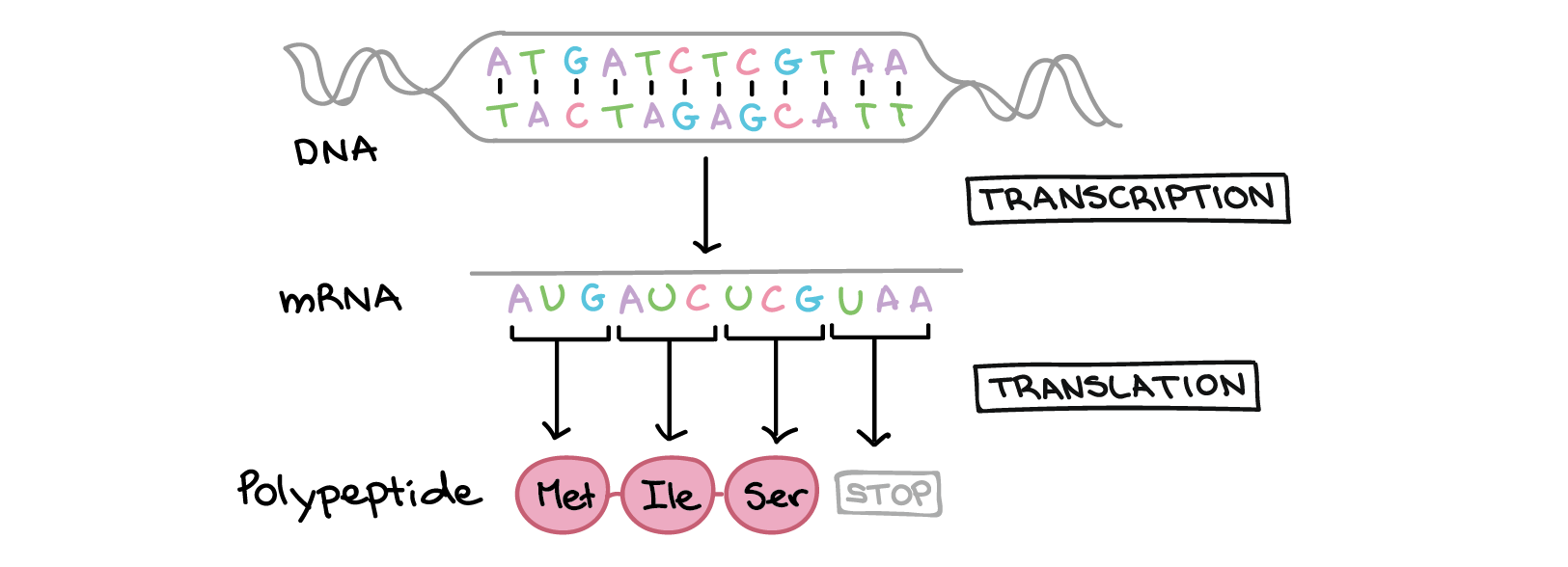12. The genetic code specifies the correspondence between each triplet codon in mRNA and the amino acid it codes for. But how are the amino acids assembled into a polypeptide according to the information in mRNA?
12. The genetic code specifies the correspondence between each triplet codon in mRNA and the amino acid it codes for. But how are the amino acids assembled into a polypeptide according to the information in mRNA?
Synthesizing a protein with the help of the information in RNA is similar to translating a language to another. A four-letter language is translated to 20 letter language during protein synthesis. There should be a specific relationship among the four bases of DNA and sequence of 20 amino acids in the protein.
What is a Genetic Code?
The genetic code can be defined as the set of certain rules using which the living cells translate the information encoded within genetic material (DNA or mRNA sequences). The ribosomes are responsible to accomplish the process of translation. They link the amino acids in an mRNA-specified (messenger RNA) order using tRNA (transfer RNA ) molecules to carry amino acids and to read the mRNA three nucleotides at a time.
Genetic Code Table
The complete set of relationships among amino acids and codons is said to be a genetic code which is often summarized in a table.

It can be seen that many amino acids are shown in the table by more than one codon. For example, there are six ways to write leucine in mRNA language.
Note: A codon is a sequence of three nucleotides which together form a unit of genetic code in a DNA or RNA molecule.
A key point of the genetic code is its universal nature. This indicates that virtually all species with minor exceptions use the genetic code for protein synthesis.
In other words, genetic code is defined as the nucleotide sequence of the base on DNA which is translated into a sequence of amino acids of the protein to be synthesized.
Properties of Genetic Code
- Triplet code
- Non-ambiguous and Universal
- Degenerate code
- Nonoverlapping code
- Commaless
- Start and Stop Codons
- Polarity
These properties of genetic code are explained below.
Triplet code
A codon or a code word is defined as a group of bases that specify an amino acid. There is strong evidence, which proves that a sequence of three nucleotides codes for an amino acid in the protein, i.e., the code is a triplet.
The four bases of nucleotide i.e, (A, G, C, and U) are used to produce three-base codons. The 64 codons involve sense codons (that specify amino acids). Hence, there are 64 codons for 20 amino acids since every codon for one amino acid means that there exist more than code for the same amino acid.
the amino acids assembled into a polypeptide according to the information in mRNA :
Transcription and translation
Mutations
Substitutions
- Silent mutations do not affect the sequence of amino acids during translation.
- Nonsense mutations result in a stop codon where an amino acid should be, causing translation to stop prematurely.
- Missense mutations change the amino acid specified by a codon.
Insertions and deletions
conclusion :
- Amino acids are not made during protein synthesis. Some students think that the purpose of protein synthesis is to create amino acids. However, amino acids are not being made during translation, they are being used as building blocks to make proteins.
- Mutations do not always have drastic or negative effects. Often people hear the term "mutation" in the media and understand it to mean that a person will have a disease or disfigurement. Mutations are the source of genetic variety, so although some mutations are harmful, most are unnoticeable, and many are even good!
- Insertions and deletions that are multiples of three nucleotides will not cause frameshift mutations. Rather, one or more amino acids will just be added to or deleted from the protein. Insertions and deletions that are not multiples of three nucleotides, however, can dramatically alter the amino acid sequence of the protein.



Comments
Post a Comment